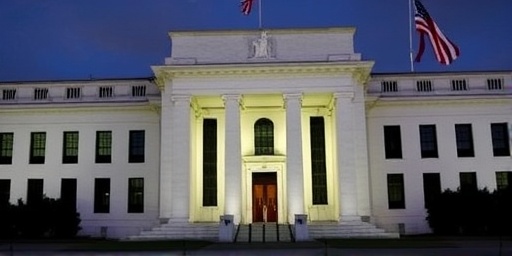In a pivotal moment for the U.S. economy, Federal Reserve Chair Jerome Powell delivered remarks that have ignited hopes for monetary policy relief. Speaking after the latest Federal Open Market Committee (FOMC) meeting, Powell indicated that a 25-basis-point rate cut in December is increasingly likely, driven by softer-than-expected CPI data signaling a meaningful slowdown in inflation. This potential easing comes after a prolonged period of aggressive interest rate hikes aimed at taming post-pandemic price surges, offering a glimmer of optimism to consumers and businesses grappling with elevated borrowing costs.
Powell’s Cautious Optimism on Inflation Trends
Jerome Powell’s comments during the post-meeting press conference underscored a shift in the Federal Reserve‘s outlook. ‘The recent CPI data has been encouraging, showing inflation cooling more rapidly than anticipated,’ Powell stated, emphasizing that core inflation measures, which exclude volatile food and energy prices, rose by just 0.2% in September, below the forecasted 0.3%. This marks a significant departure from the double-digit inflation peaks seen in 2022, when annual CPI hovered around 9.1%.
The Federal Reserve has been laser-focused on its dual mandate of price stability and maximum employment. With unemployment holding steady at 4.1% and wage growth moderating, the central bank now views the risks of over-tightening as balanced against persistent inflationary pressures. Powell reiterated that while progress is evident, the Fed remains data-dependent. ‘We are not there yet, but the path forward suggests we can begin normalizing interest rates without reigniting inflation,’ he added.
Historical context adds weight to these signals. The current federal funds rate stands at 5.25% to 5.50%, the highest in over two decades, following 11 rate hikes since March 2022. These increases successfully brought headline inflation down to 3.7% year-over-year in September, per the Bureau of Labor Statistics’ CPI report. Yet, shelter costs and services inflation continue to linger above the Fed’s 2% target, prompting cautious language from policymakers.
Breakdown of Softer-Than-Expected CPI Data
The September CPI data, released earlier this month, served as the catalyst for the Federal Reserve’s dovish tilt. Headline CPI increased by 0.1% month-over-month, far below economists’ expectations of 0.2%, and the annual rate eased to 2.4% from 2.5% in August. Core CPI, a key metric for the Fed, decelerated to 3.3% annually, the lowest since April 2021.
Several factors contributed to this cooling. Energy prices dipped 2.3% in September, with gasoline falling 3.7%, providing immediate relief to household budgets. Food inflation moderated to 2.2%, down from 2.4% the prior month, as supply chain disruptions from earlier years fade. However, sticky components like used vehicles (down 0.9%) and apparel (up only 0.1%) highlight uneven progress.
- Key CPI Metrics: Headline: 2.4% YoY; Core: 3.3% YoY; Month-over-Month Change: 0.1%
- Compared to Expectations: Economists polled by Reuters anticipated 2.3% headline and 3.6% core
- Implications for Inflation: PCE index, the Fed’s preferred gauge, is projected to follow suit in upcoming reports
Analysts attribute much of the disinflation to the lagged effects of prior rate hikes, which have curbed consumer spending and business investment. Mortgage rates, now averaging 6.8%, have slowed the housing market, indirectly easing rental inflation. Still, Fed officials like Vice Chair Lael Brainard have warned that geopolitical tensions, including Middle East conflicts, could reverse energy price gains and complicate the inflation picture.
Market Enthusiasm Fuels Bond Rally and Stock Gains
Wall Street wasted no time responding to the Federal Reserve’s signals. U.S. Treasury yields tumbled across the curve, with the 10-year note dropping to 4.05% from 4.15% pre-announcement, reflecting bets on lower interest rates ahead. The S&P 500 surged 1.2% on the day of Powell’s remarks, while the Nasdaq Composite climbed 1.8%, buoyed by tech stocks sensitive to borrowing costs.
Bond markets, often a leading indicator of Fed expectations, priced in a 75% probability of a December rate cut, up from 60% prior to the CPI data release. Futures markets now anticipate three quarter-point reductions by mid-2024, potentially bringing the federal funds rate to around 4.5%. This shift has lowered mortgage refinancing activity but sparked optimism in rate-sensitive sectors like real estate and autos.
Investors like those at BlackRock expressed relief, with portfolio manager Rick Rieder noting, ‘The Fed’s pivot validates our view that inflation’s peak has passed, allowing for a soft landing.’ However, volatility persists; the VIX index, Wall Street’s fear gauge, spiked briefly amid concerns over fiscal policy under a potential new administration.
Broader market implications extend to corporate debt. With interest rates poised for a rate cut, companies facing refinancing in 2024 could see borrowing costs ease by hundreds of basis points. Consumer confidence indices, such as the University of Michigan’s, rose to 68.9 in October, partly on expectations of cheaper credit.
Economic Ramifications of a Looming Rate Cut
A December rate cut by the Federal Reserve could ripple through the economy in profound ways. For households, lower interest rates would reduce monthly payments on variable-rate debts like credit cards, now averaging 21% APR, and adjustable-rate mortgages. The average American family could save up to $200 monthly on a $300,000 home loan if rates fall to 6.2% from current levels.
Businesses stand to benefit as well. Small enterprises, which comprise 99% of U.S. firms, have been squeezed by high borrowing costs for expansion. A rate cut could unleash pent-up investment in capital equipment and hiring, potentially adding 0.5% to GDP growth in 2024, according to projections from the Conference Board.
Yet, challenges remain. Inflation, while cooling, is not vanquished; the Fed’s dot plot still projects rates above neutral through 2025. Labor market resilience, with 254,000 jobs added in September, reduces urgency for deeper cuts. Economists at Goldman Sachs forecast a ‘shallow easing cycle’ to avoid overheating, warning that premature action could undo disinflation gains.
Globally, the U.S. move influences emerging markets. Countries like Mexico and Brazil, with currencies tied to the dollar, may follow suit with their own rate adjustments. The European Central Bank, facing similar inflation woes, watched Powell’s speech closely, potentially accelerating its own pivot.
Looking Ahead: Fed’s Data-Driven Path and Investor Strategies
As the Federal Reserve navigates this inflection point, upcoming data releases will be crucial. The October jobs report, due November 3, could sway December’s decision; strong payroll gains might temper cut expectations, while softening could accelerate them. November’s CPI data, expected mid-month, will provide fresh insights into inflation’s trajectory, with forecasts eyeing further deceleration to 2.3% headline.
Investors are advised to position portfolios for gradual easing. Diversifying into intermediate-term bonds and dividend-paying stocks could hedge against volatility, per Morningstar analysts. Real estate investment trusts (REITs) may rebound as commercial mortgage rates decline, while consumer discretionary sectors like travel could thrive on cheaper financing.
Longer-term, a successful rate cut cycle could cement the soft landing narrative, where inflation returns to 2% without tipping into recession. Powell emphasized vigilance: ‘Our actions will ensure sustained growth and stability.’ With markets pricing in optimism and the economy showing resilience, the stage is set for a pivotal December FOMC meeting that could redefine the interest rate landscape for years to come.
In the interim, stakeholders from Wall Street to Main Street are recalibrating. The interplay of Federal Reserve policy, interest rates, and inflation dynamics will continue to shape economic narratives, underscoring the central bank’s role as the economy’s steady hand.









